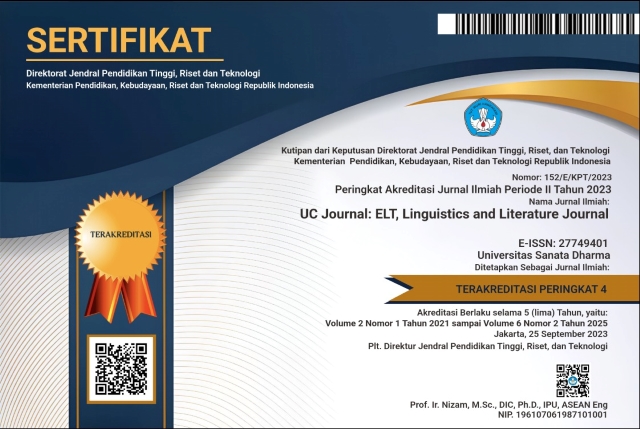CLASS CONFLICT AND CHANCE IN THOMAS HARDY’S TESS OF THE D’URBERVILLES: A MARXIST INTERPRETATION
(1) R. P. Shaha University, Bangladesh
(*) Corresponding Author
Abstract
Keywords
Full Text:
PDFReferences
Alam, M. (2010). Hardy’s social concern in Tess. The Hardy Society Journal, 6(1), 82-92. www.jstor.org/stable/48561987
Badinjki, T. (2021). Tess of the d’Urbervilles: Hardy’s nonconformist views and challenge of the prevailing social and moral ideology. Theory and Practice in Language Studies, 11(11), 1354-1358. https://doi.org/10.17507/tpls.1111.02
Basavaraju, B. (2023). The Tess of the D'Urbervilles by Thomas Hardy’s women oppression on heroine Tess. International Journal for Multidisciplinary Research (IJFMR), 5(4), 1-4.
Benyoucef, D. (2021). An ecofeminist reading of Thomas Hardy’s Tess of the d’Urbervilles and its movie adaptation by Roman Polanski: A comparative study. Pakistan Journal of Women's Studies: Alam-e-Niswan, 28(1), 61-71.
Bukhari, R. J., Asgher, T., & Parveen, S. (2021). Tess as a kaleidoscope of socially constructed images in Tess of the D'urbervilles. SJESR, 4(1), 37-43. https://doi.org/10.36902/sjesr-vol4-iss1-2021(37-43)
Chen, D., & Shi, X. (2020). Analysis of Tess’s tragic fate in Tess of the D’Urbervilles. Shanlax International Journal of English, 9(S1-i1-Dec), 21-25. https://doi.org/10.34293/english.v9is1-dec2020.3607
Cote, V. (2017). My fictional nemesis: Why Thomas Hardy’s Angel Clare is the worst. Literary Hub. https://lithub.com/my-fictional-nemesis-why-thomas-hardys-angel-clare-is-the-worst/
Dutta, K. (2010). A short history of English literature. Dhaka: Friends’ Book Corner.
Fatima, S. (2016, April 1). Economic realities, classicism and exploitation: A Marxist study of Thomas Hardy’s novel Tess of the d’Urbervilles. Academic Research International, 7(4), 116-122.
Gilmartin, S. (2016). Tess of the d’Urbervilles [Video]. YouTube. https://youtube.com/watch?v=YiDLdOUDE2Q
Handley, G. (1991). Critical studies: Tess of the d’Urbervilles. London: Penguin.
Hardy, T. (2011). Tess of the d’Urbervilles. Dhaka: Friends’ Book Corner.
Kalın, H. (2016, December 11). Tess of the D'Urbervilles [Video]. YouTube. https://www.youtube.com/watch?v=CZbg6qy8W_8
López-Narváez, J. (2021). From mommet to ugly: An analysis of the linguistic duality and idiolect of Tess Durbeyfield in the Spanish translations of Tess of the d’Urbervilles. Hikma, 20(2), 177-202. https://doi.org/10.21071/hikma.v20i2.13381
Marx, K., & Engels, F. (1848). The communist manifesto (S. Moore, Trans.). Moscow: Progress Publishers.
Memeti, S. I. (2018). Tess, victim of hypocrisy: Tess of the d’Urbervilles, Thomas Hardy. Knowledge International Journal, 28(7), 2379–2382. https://doi.org/10.35120/kij29082379s
Nuruzzaman, M. (2017). Tess in Hardy’s Tess of the d’Urbervilles: The other self of nature. CROSSINGS, 8, 153-159. https://doi.org/10.59817/cjes.v8i.139
Peng, Y., & Yan, R. (2018). An analysis of tragedy of Tess of the D'Urbervilles. English Language Teaching, 11(7), 71-75. https://doi.org/10.5539/elt.v11n7p71
Qureshi, L. (2021). “Now all was contrary to her expectation”: Destructive expectations in Tess of the d’Urbervilles. Journal of Student Research, 10(1), 1–6. https://doi.org/10.47611/jsr.v10i1.1123
Saeed, N., Shaikh, M. A., John, S., & Haider, K. (2020). Thomas Hardy: A torchbearer of feminism representing sufferings of Victorian era women. International Journal of Applied Linguistics & English Literature, 9(3), 55-61. https://doi.org/10.7575/aiac.ijalel.v.9n.3p.55
The Library. (2023). Tess of the d'Urbervilles by Thomas Hardy | Book Summary. [Video]. YouTube. https://www.youtube.com/watch?v=YztNQgnogSM
Trotter, D. (2020). The telegraphic principle in nineteenth-century fiction. In D. Trotter (Ed.), The literature of connection: Signal, medium, interface, 1850-1950 (pp. 21-52). Oxford: Oxford University Press. https://doi.org/10.1093/oso/9780198850472.003.0002
Wadhwani, H. (2024, January 30). Tess of the d'Urbervilles by Thomas Hardy - NET SET | British Literature [Video]. YouTube. https://www.youtube.com/watch?v=yes5uuROBVs
Zhang, X., & Li, Y. (2020). A comparative analysis of the causes of the heroine's tragedy in Tess of the D'Urbervilles and A Rose for Emily. Theory and Practice in Language Studies, 10(8), 988-992. https://doi.org/10.17507/tpls.1008.19
DOI: https://doi.org/10.24071/uc.v5i2.9541
Refbacks
- There are currently no refbacks.
Copyright (c) 2024 Md. Nuruddin Pier Shihab

This work is licensed under a Creative Commons Attribution-ShareAlike 4.0 International License.
UC Journal is indexed in:
UC Journal Sinta 4 Certificate (S4 = Level 4)
We would like to inform you that UC Journal: ELT, Linguistics and Literature Journal, or UC Journal has been nationally accredited Sinta 4 by the Ministry of Education, Culture, Research and Technology of the Republic of Indonesia based on the decree No. Surat Keputusan 152/E/KPT/2023. Validity for 5 years: Vol 2 No 1, 2021 till Vol 6 No 2, 2025
DOI: https://doi.org/10.24071/uc
e-ISSN (validity starting Vol 1, No 2, November 2020): 2774-9401

This work is licensed under CC BY-SA.
Creative Commons Attribution-ShareAlike 4.0 International License
 UC Journal: ELT, Linguistics and Literature Journal, a scientific peer-reviewed journal, was established in 20 May 2020 and is published twice a year, namely in May and November, by the English Language Education Study Programme (S1/Sarjana PBI) in collaboration with the English Education Master's Programme (S2/Magister PBI) of Sanata Dharma University, Yogyakarta, Indonesia.
UC Journal: ELT, Linguistics and Literature Journal, a scientific peer-reviewed journal, was established in 20 May 2020 and is published twice a year, namely in May and November, by the English Language Education Study Programme (S1/Sarjana PBI) in collaboration with the English Education Master's Programme (S2/Magister PBI) of Sanata Dharma University, Yogyakarta, Indonesia.















